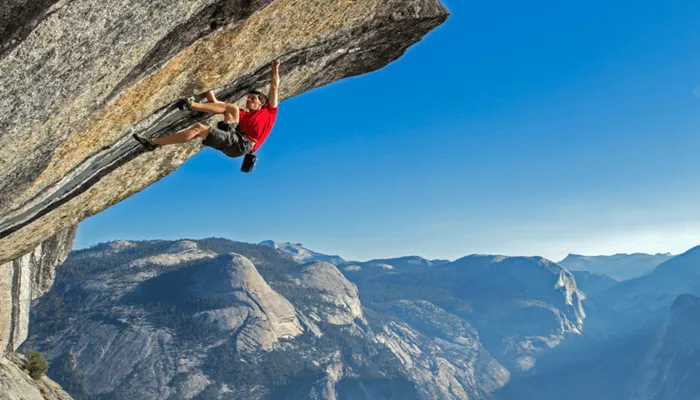Free solo climbing is an extreme form of rock climbing where the climber ascends alone, without any ropes, harnesses, or protective gear. It is considered the purest and most dangerous form of climbing, as a single fall can result in severe injury or death even from relatively low heights such as 20 feet. Unlike traditional free climbing, which uses ropes and anchors for safety, free solo climbers rely solely on their physical skill, mental focus, and familiarity with the route.
This discipline pushes the limits of human ability and psychological endurance. Climbers must be supremely confident in their technique and route knowledge while managing the constant awareness of mortal risk. The sport has gained wider public attention through documentaries like Free Solo, featuring Alex Honnold’s historic rope-free ascent of El Capitan in Yosemite National Park.
What Is Free Solo Climbing?
Free solo climbing involves ascending rock faces using only hands and feet, without any form of artificial aid or protection.
The only equipment typically used are climbing shoes and chalk to improve grip. Unlike free climbing, which may use ropes and anchors for safety, free soloing means no safety net exists.
This form of climbing is distinct from:
Sport climbing: Uses pre-placed bolts and ropes for protection.
Traditional climbing: Places removable protection gear while climbing.
Rope soloing: Climbers ascend alone but use ropes and self-locking devices for safety.
Free soloing is often attempted on routes well within the climber’s ability to minimize risk, but accidents still occur even on familiar climbs. The stakes are extremely high, making free solo climbing one of the most mentally and physically demanding sports.
The Mental Aspect of Free Solo Climbing
Free solo climbing requires extraordinary mental discipline. Climbers must face the reality of death or serious injury with calm focus. Unlike other climbing forms where ropes offer psychological security, free soloists must manage fear and stress directly.
Key mental strategies include:
Intentional focus: Concentrating fully on each move without distraction.
Acceptance of risk: Embracing the possibility of fatal falls rather than avoiding it.
Practice in no-fall zones: Training on routes where falling is unlikely to build confidence.
Down-climbing skills: Being able to retreat safely if needed.
This mental training is as critical as physical preparation and often defines the success or failure of a free solo climb.
History and Evolution of Free Solo Climbing
Free solo climbing has roots in the early days of rock climbing when protective gear was minimal or ineffective. Early climbers like W. P. Haskett Smith and Paul Preuss practiced free soloing as an ethical ideal of pure climbing without aid.
By the 1970s, as climbing protection technology improved, free solo climbing emerged as a distinct discipline focused on risk and commitment. Notable milestones include:
The 1958 ascent of Goliath by Don Whillans, done effectively as a free solo with minimal rope protection.
Alex Honnold’s groundbreaking free solo of El Capitan in 2017, considered the pinnacle of free solo achievement.
Famous Free Solo Climbs and Climbers
Alex Honnold and El Capitan
Alex Honnold’s free solo climb of El Capitan, a 3,200-foot granite face in Yosemite, is widely regarded as the “moon landing” of free soloing. His ascent required immense physical skill and mental control, as the route’s sheer verticality and length make any fall fatal.
Before El Capitan, Honnold made notable free solo ascents of Half Dome and Moonlight Buttress, setting new standards for difficulty and commitment in the sport.
Other Notable Climbers
Bruce Means, known for free solo climbs in remote locations such as the tepuis of Guyana.
Early pioneers like Paul Preuss, who advocated for climbing without aid as an ethical practice.
How to Learn Free Solo Climbing
Free solo climbing is not recommended for beginners or even intermediate climbers due to its extreme risks. However, those interested in learning the discipline typically follow a gradual training process:
Master basic free climbing skills: Develop strong technique on protected routes.
Practice low-risk soloing: Climb short, easy routes without ropes in controlled environments.
Incrementally increase difficulty: Solo climbs that are well within ability and familiar.
Mental training: Learn to manage fear and maintain focus under pressure.
Climbers often use protection during training phases, gradually reducing reliance on it to simulate free solo conditions safely.
Risks and Controversies
Free solo climbing carries an inherent risk of fatal falls. Even the most experienced climbers have died attempting free solo routes. This has led to debate within the climbing community about the ethics and responsibility of free soloing.
Critics argue it is reckless and selfish, potentially endangering rescue teams and setting dangerous examples. Supporters view it as the ultimate expression of climbing skill and personal challenge, emphasizing preparation and respect for risk.
Equipment Used in Free Solo Climbing
Unlike other climbing styles, free solo climbers use minimal equipment:
Climbing shoes: Provide grip and precision on rock surfaces.
Chalk: Keeps hands dry for better holds.
Clothing: Lightweight and flexible for freedom of movement.
No ropes, harnesses, or protective gear are used, which increases the danger but also the purity of the climb.
Conclusion
Free solo climbing is a high-risk, high-reward extreme sport that combines physical prowess with intense mental focus. It is distinguished by the absence of any protective equipment, making the margin for error nonexistent. While it remains controversial due to its dangers, free solo climbing continues to captivate climbers and spectators alike for its raw display of human skill and courage.
Only a few elite climbers, such as Alex Honnold, have pushed the boundaries of what is possible in free solo climbing, achieving feats that inspire awe and redefine the limits of the sport. For those who pursue it, free solo climbing is not just a sport but a profound personal journey confronting fear, mastery, and mortality.

